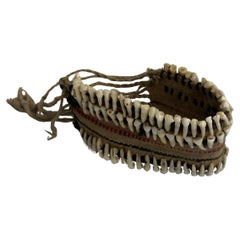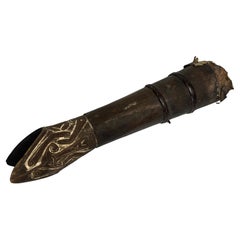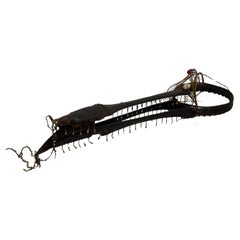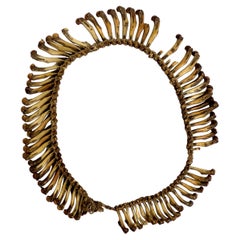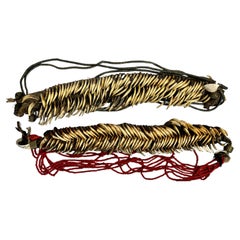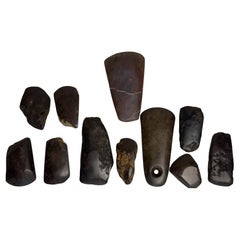Tribal Art
to
194
740
526
1,384
21
8
74
12
10
10
1
1
1
44
215
1,125
29
445
438
77
8
4
20
28
19
33
33
22
17
4
687
286
209
153
95
763
628
369
195
150
1,413
1,407
1,412
55
25
13
9
8
Tribal Art For Sale
A monkeytooth bracelet from the Philippines
Located in Amsterdam, NL
Philippines, late 19th/early 20th century
Provenance:
Sammlung Rinck-Hollnberger, Munich (purchased the 1980s-1990s)
Category
Late 19th Century Philippine Antique Tribal Art
Materials
Natural Fiber, Teeth
A Baimaru Kundu drum from the Schulze Westrum collection
Located in Amsterdam, NL
New Guinea, Papua Gulf, probably Baimaru people, late 19th–early 20th century
H. 81.5 x Diam. 15 cm.
Provenance:
- Collected by German biologist and cinematographer Thomas Schulze-...
Category
Early 20th Century Papua New Guinean Tribal Art
Materials
Animal Skin, Wood
An Illongot headdress
Located in Amsterdam, NL
Ifugao, Northern Philippines, 19th century
Decorated with different kinds of beadwork and the bill of a Kalaw bird (hornbill).
Historically, only those who had proven themselves th...
Category
19th Century Philippine Antique Tribal Art
Materials
Shell, Natural Fiber, Wood, Beads
$2,882
An Asmat ceremonial trophy necklace
Located in Amsterdam, NL
Asmat People, South Papua, Indonesia, probably late 19th century
The Asmat people of Papua are known for creating "trophy necklaces," intricate pieces often made from human bones an...
Category
Late 19th Century Indonesian Antique Tribal Art
Materials
Bone, Natural Fiber
Two Naga hunting trophy chains
Located in Amsterdam, NL
Nagaland, North-east India, early 20th century
Probably made from dogteeth.
Category
Early 20th Century Indian Tribal Art
Materials
Shell, Beads, Teeth
An elaborate collection of stone tools used by the Mapuche culture
Located in Amsterdam, NL
Mapuche Culture, Southern Chile, Pre-Columbian
A collection of eleven stone tools all varying in sizes.
Category
15th Century and Earlier Chilean Antique Tribal Art
Materials
Stone
An exquisite warrior's headdress or 'Kaibauk'
Located in Amsterdam, NL
Amarasi district, Kupang regency, West Timor island, early 20th century
Category
Early 20th Century Timorese Tribal Art
Materials
Metal
Very rare Melanesian armbands made of woven palm fibers and tiny shells
Located in Amsterdam, NL
Melanesia, Southwestern Pacific Ocean, 19th century
Some very rare Melanesian armbands made of woven palm fibers and tiny shells, dating from the 19th century (at least).
This typ...
Category
19th Century Solomon Islands Antique Tribal Art
Materials
Shell, Natural Fiber
Two spearheads used as currency by the Bangala people of the Congo
Located in Amsterdam, NL
Democratic Republic of Congo, late 19th century
These spearheads looked like weapons, yet they were hardly ever used in battle. Rather, they functioned as a kind of money that was u...
Category
Late 19th Century Congolese Antique Tribal Art
Materials
Iron
A delicate tortoiseshell 'armband' from the Lower Sepik River Province
Located in Amsterdam, NL
Sepik River Province, Papua New Guinea, probably late 19th century
Tortoiseshell bracelets are frequently more than just ornaments in Sepik River civilizations; they are representat...
Category
Late 19th Century Papua New Guinean Antique Tribal Art
Materials
Tortoise Shell
A Polynesian war-club or 'Gata waka'
Located in Amsterdam, NL
Fiji, probably early 20th century
Polynesian culture is traditionally a culture of power and prestige, and there was a fine line between battle and ceremony. Warrior people par exce...
Category
Early 20th Century Fijian Tribal Art
Materials
Hardwood
A Maasai throwing club or 'rungu'
Located in Amsterdam, NL
Maasai, African Great Lakes Region, Probably early 20th century
The 'rungu' is a traditional weapon and emblem of authority among the Maasai people of East Africa, especially in Ken...
Category
Early 20th Century Kenyan Tribal Art
Materials
Hardwood
An Anthropomorphic Celt Axe God Pendant
Located in Amsterdam, NL
Central-America, Costa-Rica, Pre-Columbian
Jadeite and other greenstones were utilized in a diverse array of items that served as symbols of social and political power. Among the mo...
Category
15th Century and Earlier Costa Rican Antique Tribal Art
Materials
Stone
An engraved Sepik cassowary bone dagger
Located in Amsterdam, NL
Papua New Guinea, Sepik Region, Abelam people, early 20th century
Bone daggers in the Sepik region are traditionally crafted from the thigh bone of the ca...
Category
Late 19th Century Papua New Guinean Antique Tribal Art
Materials
Bone
Konyak naga-necklace with brown beads
Located in Amsterdam, NL
Naga Konyak, North-India, early 20th century
The Konyaks, the largest of the Naga ethnic groups, reside primarily in the districts of Tirap, Longding, and Changlang in Arunachal Pra...
Category
Early 20th Century Indian Tribal Art
Materials
Beads
A Solomon Islands red feather money coil or 'Tevau'
Located in Amsterdam, NL
Santa Cruz, Nendö, late 19th/early 20th century
Retaining an original leaf in which these coils were wrapped.
L. 72 cm (stretched out)
Diam. 34 cm (roll)
One of the most remarkabl...
Category
Late 19th Century Solomon Islands Antique Tribal Art
Materials
Feathers
An ancient Papua wooden substitute headhunters's head
Located in Amsterdam, NL
Papua New Guinea, 18th-19th century
L. 22.5 x W. 18 cm (approx.)
Provenance:
Collected by Schulze-Westrum
Collection Rinck Hollnberger, Munich (purchased in the 1980s or 1990s)
For a comparable skull see the collection of the Metropolitan Museum of Art in New York.
The heads of humans and of animals such as crocodiles and pigs formerly played integral roles in the ceremonial life of Papuan Gulf peoples, who considered the heads to be vessels of life-giving supernatural power. Within men’s ceremonial houses, human skulls were displayed, together with sacred images such as spirit boards or gope, by the members of each clan in a specially constructed clan shrine. However, not all heads required the death of an enemy. In some areas, heads made from wood or other materials appear to have had powers equal to actual ones. In contrast to skulls, the facial features of wood heads were sometimes depicted as they appeared in life.
This example comes from the Wapo Creek area, where wood heads appear to have been used interchangeably with actual skulls. When headhunting was abolished by Australian colonial...
Category
19th Century Papua New Guinean Antique Tribal Art
Materials
Wood
A rare Papua 'Gope' Spirit board from the Schulze Westrum collection
Located in Amsterdam, NL
A rare Papua 'Gope' Spirit board from the Schulze Westrum collection
New Guinea, Papua Gulf, probably Urama people, late 19th–early 20th century
Attached to the back are several 'b...
Category
Late 19th Century Papua New Guinean Antique Tribal Art
Materials
Wood
A rare Papua 'Gope' Spirit board from the Schulze Westrum collection
Located in Amsterdam, NL
A rare Papua 'Gope' Spirit board from the Schulze Westrum collection
New Guinea, Papua Gulf, probably Minagoiravi, Wapo River, late 19th–early 20th century
H. 130 x W. 24.5 cm
Pro...
Category
Late 19th Century Papua New Guinean Antique Tribal Art
Materials
Wood
A rare Papua 'Gope' Spirit board from the Schulze Westrum collection
Located in Amsterdam, NL
A rare Papua 'Gope' Spirit board from the Schulze Westrum collection
New Guinea, Papua Gulf, probably Urama people, late 19th–early 20th century
H. 114 x W. 27 cm
Provenance:
- Co...
Category
Late 19th Century Papua New Guinean Antique Tribal Art
Materials
Wood
Antique Anatolian Bergama Heybe Bags, Late 19th Century
Located in San Francisco, CA
Antique Anatolian Turkish Bergama Heybe Bags Rug, Late 19th Century
Additional Information:
Dimensions: 1'8" W x 4'2" L
Origin: Anatolia (Turkey)
Period: Late 19th Century
Rug ID: 1...
Category
Late 19th Century Persian Antique Tribal Art
Materials
Wool
Antique Persian Afshar Bagface, c. 1900
Located in San Francisco, CA
Antique Persian Afshar Bagface Bag, c. 1900
This highly graphic Afshar bag face draws a large central indigo-blue hexagon against a complimentary contrasting terra cotta field. Both...
Category
19th Century Persian Antique Tribal Art
Materials
Wool
A Nias 'Adu Zatua' wooden ancestor sculpture
Located in Amsterdam, NL
Indonesia, Nias, 19th century
H. 37.5 x W. 10 cm
Sculptures like the one present are not only decorative items but are believed to be vessels that house the spirits of ancestors and are used to communicate with them.
After the death of a person a wooden image or Adu Zatua was made to mediate between the human world and the spiritual realm. These kinds of figures were commissioned by noble Nias families, whereas simple and lesser quality carvings generally were found among lower class families.
In this particularly fine example, the sculptor has paid careful attention to the proportions of the different parts of the body, dividing it into three main sections – the head, the torso, and the legs. The shapes are sometimes flat, round, or have notches, but all are perfectly in balance creating a certain divine tranquillity. This Adua Zatua’s ears are decorated with earrings, and it is wearing a headdress, pointing towards a chiefly provenance.
In 1914 the Dutch gained complete control of the island of Nias and started spreading Protestant Christianity. Many ancestor statues...
Category
19th Century Indonesian Antique Tribal Art
Materials
Wood
Ashanti African Chief’s ceremonial gold and gilt-metal crown and sash on stand
Located in Amsterdam, NL
An Ashanti Chief’s ceremonial gold and gilt-metal crown and sash
Ghana, early 20th century
Diam. 20 cm (crown)
L. 128 cm (sash)
H. 102 cm (incl. st...
Category
Early 20th Century Ghanaian Art Nouveau Tribal Art
Materials
Gold, Gold Plate, Metallic Thread
African Chief’s gilt Crown and Sceptre in the form of a Pith helmet and pipe
Located in Amsterdam, NL
A splendid Bouelé Chief’s gilt-wood crown and sceptre in the form of a Pith helmet and pipe
Ivory coast, late 19th/early 20th century
H. 13 x L. 33.5 x D. 26 cm (crown)
L. 14 cm ...
Category
Early 1900s Ivorian Antique Tribal Art
Materials
Giltwood
Polychrome Wood Model of an Indonesian Toraja Dwelling or Tongkonan, C. 1900
Located in Amsterdam, NL
A polychrome wood model of a Toraja dwelling or tongkonan
Indonesia, Sulawesi, Tana Toraja, early 20th century
H. 60 x L. 94 x D. 33 cm
Provenance:
- Seminary Rosa Stichting, Nijmegen
- Instituut voor Kulturele Antropologie van de Katholieke Universiteit, Nijmegen
- With Michel Thieme...
Category
Early 20th Century Indonesian Tribal Art
Materials
Wood
$3,832 Sale Price
20% Off
Large Brazilian or Guyana Amazon Indigenous Macana War Club, 18th or Earlier
Located in Amsterdam, NL
A splendid and rare Amazon indigenous wamara wood Macana war-club
Southern-Guyana or Northern Brazil, Wapitxana group of the Aruak peoples, 18th century, possibly earlier
Measure: H. 43 cm
The deep patina of the club present, and the residue on the part where it was held, attest to its great age.
This unusually large Macana is decorated with several incised whitened anthropomorphic and human figures, a decoration only found on one other documented club in the British Museum, which is illustrated in: Hjalmar Stolpe, Amazon Indian...
Category
Early 18th Century Brazilian Antique Tribal Art
Materials
Hardwood
18th Century Polynesian Hardwood Ula Tavatava or Throwing War Club from Fiji
Located in Amsterdam, NL
A Polynesian hardwood Ula tavatava or throwing war club
Fiji, probably 18th century
All-over decorated in incised pattern, the bulbous top seems to have a stone grown into it.
H. 42 cm
Including museum-quality powder-coated stand.
Provenance:
Private collection, France
Polynesian culture is traditionally a culture of power and prestige, and there was a fine line between battle and ceremony. Warrior people par excellence, the Fijians had at their disposal a large panoply of weapons, each for a specific use.
The elegant Gata are called gun-sticks by Europeans due to the recognizable form. However, they are designed after a snake, gata in Fijian language. The Ula throwing clubs...
Category
18th Century Fijian Antique Tribal Art
Materials
Hardwood
18th Century Polynesian Ironwood Gata Waka or War Club from Fiji
Located in Amsterdam, NL
A Polynesian ironwood Gata waka or war club
Fiji, probably 18th century or earlier
Measures: Height. 97 cm
Including museum-quality powder-coated stand.
Provenance:
Private collection, France
Polynesian culture is traditionally a culture of power and prestige, and there was a fine line between battle and ceremony. Warrior people par excellence, the Fijians had at their disposal a large panoply of weapons, each for a specific use.
The elegant Gata are called gun-sticks by Europeans due to the recognizable form. However, they are designed after a snake, gata in Fijian language. The Ula throwing clubs...
Category
18th Century Fijian Antique Tribal Art
Materials
Hardwood
Early Papua Korwar Ancestor Figure, Early 19th Century, Deep Black-Brown Patina
Located in Amsterdam, NL
An extremely rare Papua wood sculpture of a Korwar
Papua New Guinea, Cendrawasih Bay, Wandammen, early 19th century
Measures: Height 24 x Diameter 18 cm
Finely carved in th...
Category
Early 19th Century Indonesian Tribal Antique Tribal Art
Materials
Wood
Fine Jelutong Wood Borneo Dayak Kliau or Shield, First Half of the 19th Century
Located in Amsterdam, NL
A fine Jelutong wood Dayak Kliau or shield
Indonesia, Borneo, Kalimantan, first half of the 19th century
Measures: H. 126 x W. 36 cm
The kliau or klebit is the most popular ...
Category
19th Century Indonesian Tribal Antique Tribal Art
Materials
Wood
American Diorama, Follower Gerrit Schouten, Carib Indigenous Village
Located in Amsterdam, NL
Follower of Gerrit Schouten (second half of the 19th century)
Diorama depicting a Carib Indigenous camp
Carved wood, papier-mâché, paint on paper...
Category
19th Century Surinamer Antique Tribal Art
Materials
Clay, Twig, Wood, Paper, Feathers
Early Papua Korwar Statue, Collection of Missionary Starrenburg, Collected 1909
Located in Amsterdam, NL
A Papua wood figure of a Korwar
North West Irian Jaya, Vogelkop area, coastal Geelvink Bay, present-day Cenderawasih Bay, early 20th century
The seated Korwar is holding an ope...
Category
Early 20th Century Indonesian Tribal Tribal Art
Materials
Wood
